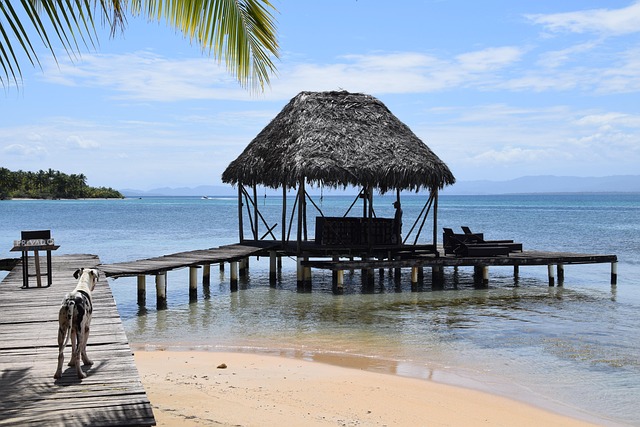Venture Beyond Expectations into Vibrant Ngäbe Culture
The boat skimmed beside a curtain of bruised sky, the sea shining like Windexed glass while black-tipped clouds argued about bursting. I zipped my rain jacket, tugged on my wellies, and watched our captain thread the hull toward what looked like nothing at all: a thin seam in the mangroves, a doorway only a local could read. Most visitors sweep past these quiet openings on their way to beaches and bars. That morning, we turned in. The world changed.
Bocas del Toro is famous for sun-spilled hammocks and reggae-soaked nights, for dancing until sweat replaces sand and for the sort of happy hour that arrives early and refuses to leave. That postcard is true. It’s just not the whole picture. Slip into the mangroves and you discover another Bocas—one that belongs to the Ngäbe, Panama’s largest Indigenous people, whose homelands include these islands and the forest-laced channels that hold them together. Here the soundtrack is paddle taps and heron calls; the stories are older than any pirate bar.
History has not been gentle to the Ngäbe. Waves of outsiders—explorers, fruit companies, then global tourism—pushed and re-shaped their world. Yet resilience runs deep. What you meet in places like Salt Creek is culture held intact: knowledge of cacao and medicinal plants, forest-to-table cooking, weaving and carving traditions, a lived relationship with land and tide. When you visit with respect—and pay fairly—you’re not buying a souvenir; you’re helping keep knowledge alive where it has always belonged.
The channel narrowed and the light cooled as mangrove roots stitched the surface into lace. Rain pattered, then gave up, leaving the air rinsed. We tied up at a modest dock, the kind that suggests you’ve arrived somewhere that doesn’t care for fuss. A wooden path led to a clearing where our hosts outlined the day: walk the forest trail for wildlife and edible greens; learn to spot the elegant crown of a heart-of-palm; taste cacao at its source; watch craftswomen transform gathered fibres into baskets and bracelets—colours pulled from leaves, bark and seed. Lunch would be what we found together, guided by hands that have seasoned pots here for generations.
On the trail, the forest taught at its own pace. Heliconias threw red spears into the shade, a sloth rippled like moss brought to life, and a troop of capuchins stitched the canopy with chatter. Our guide brushed a palm frond and told a story about healing fevers; he crushed a leaf and the air bloomed minty-sharp. We harvested hearts of palm with careful cuts and carried them back like gifts. By midday the kitchen was a chorus—coconut cracking, firewood popping, plantain slicing. Lunch arrived as a simple feast: warm rice touched with herbs, fish grilled in banana leaf, fresh palm a little sweet and entirely clean, cacao nibs sprinkled like confetti over fruit. Nothing travelled far. Everything tasted like it belonged.
In the afternoon we watched dyes coaxed out of forest plants—saffron gold, seaweed green, a sunset maroon—and threaded into basketry that mirrored the tides. Fingers moved quickly, then paused for a joke, then quickened again. That rhythm—make, laugh, share—felt like the heartbeat of the place. Other Ngäbe-led experiences nearby open a sacred bat cave, walk you through chocolate from pod to sip (yes, tasting is very much part of the lesson), or map the forest’s pharmacy leaf by leaf. None of it is staged. All of it is the kind of learning that stays under your skin.
People often ask what they’ll “get” from a day like this. The truth? A recalibration. You leave with a better sense of what abundance looks like when it isn’t measured in beachfront real estate. You understand that tourism can pay the bill for culture rather than the other way round—if travellers choose wisely and operators elevate Indigenous leadership. You carry away flavours and textures and a few new words. Mostly, you leave with the quiet certainty that the mangrove entrance you nearly missed leads to the most generous room in the house.
If Bocas has been your place for barefoot cocktails and neon sunsets, hold on to that. Then widen the frame. Swim in the morning, dance at night—absolutely. But give a day to the people who were here first. Let your money strengthen local schools, kitchens, guides and cooperatives. Let your curiosity do something useful.
How to Seek and Set Up Indigenous Tours in Bocas
• Ask your hotel, hostel or Airbnb/B&B host to connect you with Ngäbe-run experiences—they’ll know who operates responsibly and when tides and weather align.
• Explore: Red TuCombo and Kawi Voyage – Salt Creek for community-led options, current schedules and contact details.
This is the other side of Bocas del Toro—tender, grounded, quietly dazzling—and it’s too important to miss.








